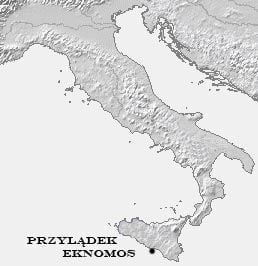Chapters
Sea battle near Cape Ecnomos (256 BCE) was fought between the Roman fleet and the Carthaginian fleet during the First Punic War. The Roman side won.
Background of events
After declaring the war (the so-called First Punic War) decided to suppress the Carthaginians’ positions in the western part of Sicily and at the same time, start building your own fleet, which was possible only thanks to property taxes (tributum) imposed on citizens. Since the Romans did not have much experience in naval combat, they began to follow the example of the Greeks. In sea battles, they introduced movable platforms with hooks, placed on the bows, which they threw onto the enemy ship, then to conduct hand-to-hand combat. They were called “ravens”. Thanks to this, the Romans began to win at sea. The great naval battle of Mylae in 260 BCE, which proved the correctness of the Roman tactics, went down in history.
Rome, at the expense of great efforts and resources, created an enormous fleet to attack Carthage itself and end a protracted, devastating war. The Carthaginians, knowing about the Roman preparations, wanted to prevent the invasion of their metropolis and ultimately destroy the enemy fleet, gaining a permanent advantage at sea.
The Romans, knowing that the enemy fleet was nearby, after loading their ground troops at the estuary of the Himera River (south of Sicily), set their ships in an unprecedented formation. The entire fleet was divided into 4 squadrons. The first two squadrons sailed diagonally to each other, led by two ships with consuls on board. The third squadron followed them, pulling on ropes and directly protecting the transport ships with the military. The fourth (called triarii) followed a wide line at the rear, closing the base of the triangle, and its edges protruding slightly beyond the third squadron and the transport ships.
The Carthaginian fleet arrived from the west in a different formation. It was also divided into 4 squadrons, one of them flowing in line formation along the coast, the other three in frontal formation, positioned one next to the other. All 4 squadrons formed a line similar to a semicircle, with the first and fourth squadrons slightly extended.
Forces
The Roman forces are estimated at 330 ships, 100,000 sailors and rowers, and 40,000 soldiers. The Romans continued to use the crows boarding piers on their ships, introduced 4 years earlier, allowing them to use well-trained soldiers in hand-to-hand combat. The Roman fleet was commanded by the consuls Marcus Attilius Regulus and Lucius Manlius Vulso.
The Carthaginian forces, in turn, consisted of 350 ships, on board of which there were 100,000 sailors and rowers, and 18,000 soldiers. The Carthaginian fleet was commanded by Hamilcar and Hanno.
Battle
At the sight of the enemy, the first two Roman squadrons moved towards the two central Carthaginian squadrons. Desiring to break the Roman formation, the commander of this section, Hamilcar, began an apparent retreat, drawing the strongest part of the Roman fleet away from the other two squadrons and transport ships. After some time, the Carthaginians turned back and attacked the consuls’ squadrons.
At the same time, the Carthaginian squadron, which had so far been sailing along the shores, attacked the third Roman squadron, seeing a gap in the enemy formation. The Roman ships immediately dropped the towing lines and went to meet the attackers, while the transporters turned and took refuge at the estuary of Himera, taking up positions on the eastern bank of the river. Fighting the third squadron, the Carthaginians pushed the enemy towards the transports, but failed to break Roman lines.
At the same time, the attack by the farthest Carthaginian squadron under the command of Hannon fell on the fourth Roman squadron. This Roman squadron also had to retreat towards the shore.
Meanwhile, the consuls forced the two central Carthaginian squadrons to flee and, after returning, attacked the squadrons blocking the transport fleet, destroying them one by one, with the simultaneous attack supporting the previously blocked ships.
The victory of the Romans was complete. Losing 24 of their own ships, they sank 30 enemy ships and captured a further 64. The Carthaginians lost nearly 40,000 killed and captured.
Consequences
This battle was one of the most important, and by some described as the most important battle of the First Punic War. It was also undoubtedly the greatest victory in the history of the Roman fleet and probably the greatest battle of antiquity. It is also considered by some to be the greatest naval battle in history. Carthage’s advantage at sea was broken, from then until the end of the war, it was Rome that had a continuous (though often small) advantage at sea.









